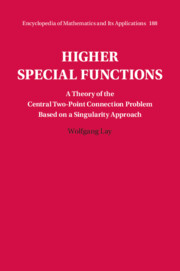 Higher Special Functions
Higher Special Functions Book contents
- Frontmatter
- Dedication
- Contents
- Preface
- Acknowledgements
- 1 Introduction
- 2 Singularities in Action
- 3 Fuchsian Differential Equations: The Cornerstones
- 4 Central Two-Point Connection Problems and Higher Special Functions
- 5 Applications and Examples
- 6 Afterword
- Appendix A Standard Central Two-Point Connection Problem
- Appendix B Curriculum Vitae of George Cecil Jaffé
- References
- Index
3 - Fuchsian Differential Equations: The Cornerstones
Published online by Cambridge University Press: 16 May 2024
- Frontmatter
- Dedication
- Contents
- Preface
- Acknowledgements
- 1 Introduction
- 2 Singularities in Action
- 3 Fuchsian Differential Equations: The Cornerstones
- 4 Central Two-Point Connection Problems and Higher Special Functions
- 5 Applications and Examples
- 6 Afterword
- Appendix A Standard Central Two-Point Connection Problem
- Appendix B Curriculum Vitae of George Cecil Jaffé
- References
- Index
Summary
Global properties now come into play. To distinguish Frobenius and Thomé solutions, we consider regular and irregular singularities of differential equations and hence Fuchsian differential equations and their confluent cases. The simplest singularity of a differential equation is a pole of at most first order in the coefficient before the first derivative and a pole of at most second order in the coefficient before the zeroth derivative. Such a singularity is called regular, otherwise it is irregular. A Fuchsian differential equation only has regular singularities; with irregular singularities it is a confluent case. We also need to consider the so-called form of a differential equation. A Fuchsian differential equation with one singularity is Laplace; two singularities is Euler; three singularities is Gauss; four singularities is Heun. While singular boundary eigenvalue problems of the Gauss differential equation and its confluent cases produce classical special functions, for the Heun differential equation and its confluent cases they produce higher special functions.
Keywords
- Type
- Chapter
- Information
- Higher Special FunctionsA Theory of the Central Two-Point Connection Problem Based on a Singularity Approach, pp. 114 - 156Publisher: Cambridge University PressPrint publication year: 2024


